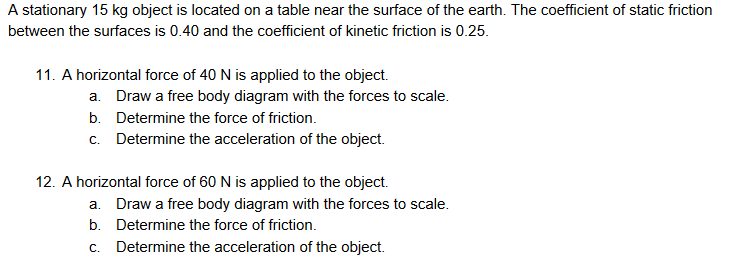A stationary 15 kg object is located on a table near the surface of the earth. The coefficient of static friction between the surfaces is 0.40 and the coefficient of kinetic friction is 0.25. 11. A horizontal force of 40 N is applied to the object. a. Draw a free body diagram with the forces to scale. b. Determine the force of friction. c. Determine the acceleration of the object. 12. A horizontal force of 60 N is applied to the object. a. Draw a free body diagram with the forces to scale. b. Determine the force of friction. c. Determine the acceleration of the object.
A stationary 15 kg object is located on a table near the surface of the earth. The coefficient of static friction between the surfaces is 0.40 and the coefficient of kinetic friction is 0.25. 11. A horizontal force of 40 N is applied to the object. a. Draw a free body diagram with the forces to scale. b. Determine the force of friction. c. Determine the acceleration of the object. 12. A horizontal force of 60 N is applied to the object. a. Draw a free body diagram with the forces to scale. b. Determine the force of friction. c. Determine the acceleration of the object.
College Physics
1st Edition
ISBN:9781938168000
Author:Paul Peter Urone, Roger Hinrichs
Publisher:Paul Peter Urone, Roger Hinrichs
Chapter4: Dynamics: Force And Newton's Laws Of Motion
Section: Chapter Questions
Problem 9PE: Suppose two children push horizontally, but in exactly opposite directions, on a third child in a...
Related questions
Question
Question 12

Transcribed Image Text:A stationary 15 kg object is located on a table near the surface of the earth. The coefficient of static friction
between the surfaces is 0.40 and the coefficient of kinetic friction is 0.25.
11. A horizontal force of 40 N is applied to the object.
a. Draw a free body diagram with the forces to scale.
b. Determine the force of friction.
c. Determine the acceleration of the object.
12. A horizontal force of 60 N is applied to the object.
a. Draw a free body diagram with the forces to scale.
b. Determine the force of friction.
C.
Determine the acceleration of the object.
Expert Solution
This question has been solved!
Explore an expertly crafted, step-by-step solution for a thorough understanding of key concepts.
This is a popular solution!
Trending now
This is a popular solution!
Step by step
Solved in 2 steps with 2 images

Knowledge Booster
Learn more about
Need a deep-dive on the concept behind this application? Look no further. Learn more about this topic, physics and related others by exploring similar questions and additional content below.Recommended textbooks for you

College Physics
Physics
ISBN:
9781938168000
Author:
Paul Peter Urone, Roger Hinrichs
Publisher:
OpenStax College

Physics for Scientists and Engineers with Modern …
Physics
ISBN:
9781337553292
Author:
Raymond A. Serway, John W. Jewett
Publisher:
Cengage Learning

Physics for Scientists and Engineers
Physics
ISBN:
9781337553278
Author:
Raymond A. Serway, John W. Jewett
Publisher:
Cengage Learning

College Physics
Physics
ISBN:
9781938168000
Author:
Paul Peter Urone, Roger Hinrichs
Publisher:
OpenStax College

Physics for Scientists and Engineers with Modern …
Physics
ISBN:
9781337553292
Author:
Raymond A. Serway, John W. Jewett
Publisher:
Cengage Learning

Physics for Scientists and Engineers
Physics
ISBN:
9781337553278
Author:
Raymond A. Serway, John W. Jewett
Publisher:
Cengage Learning

Principles of Physics: A Calculus-Based Text
Physics
ISBN:
9781133104261
Author:
Raymond A. Serway, John W. Jewett
Publisher:
Cengage Learning

Physics for Scientists and Engineers: Foundations…
Physics
ISBN:
9781133939146
Author:
Katz, Debora M.
Publisher:
Cengage Learning

College Physics
Physics
ISBN:
9781305952300
Author:
Raymond A. Serway, Chris Vuille
Publisher:
Cengage Learning